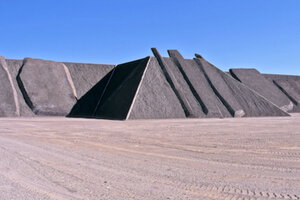Obama has now preserved more land than any other US president
President Obama declared three new national monuments, spanning more than a million acres, on Friday.

This undated photo provided by Triple Aught Foundation shows part of an artwork by Michael Heizer called "City" near Garden Valley, Nev. Mammoth bones, the prehistoric rock carvings and more than a million acres of wilderness will be protected as part of three new national monuments that President Barack Obama is creating in California, Nevada and Texas and announced Friday, July 10, 2015.
Tom Vinetz/AP/Triple Aught Foundation
President Obama exercised his right to a more than century-old policy, protecting by executive order around a million acres of public land Friday.
Under the Antiquities Act, Obama has established 19 national monuments during his presidency. Friday’s announcement of three new monuments, in Nevada, California, and Texas, brought the president to a tally of 260 million acres of protected public lands and waters – more than any other previous president.
His largest designation, the Basin and Range, spans 1,000 square miles of Nevada (a little smaller than Rhode Island) in one of the most untouched areas of the broader Great Basin region.
The new Nevada monument will protect biodiversity and migration corridors, and help preserve the history of North America’s earliest human inhabitants of 13,000 years ago, as well as the tradition of mining and ranching over the last century. The land also includes prehistoric rock art panels, and City, a land-art undertaking made of earth and concrete that spans 1 and a ½ miles. The artist Michael Heizer has been working on City for nearly 50 years, according to The Associated Press.
The designation has not been without public push back.
The Obama administration said in a fact sheet that herding and economic development would not be impeded by the designation of the Basin and Range. But according to The Washington Post, many local politicians and ranchers opposed the site, for fear of hampering both development and grazing.
Although the proclamation states it will not affect grazing, Connie Simkins, a secretary of the local grazing board within the designated area, told the Washington Post that the creation of the Great Basin National Park ultimately regulated grazing, putting a stop to it altogether.
Nevada Gov. Brian Sandoval, in a statement, said the proclamation “bypassed Congress on a public lands issue in which Nevada and our entire delegation should have had a primary role in working collectively.”
The monument in northern California’s Inner Coast Range, Berryessa Snow Mountain, encompasses nearly 331,000 acres of public land. According to a statement from the Obama administration, an independent study found that a monument designation is likely to increase visitation and could generate an additional $26 million in economic activity for the surrounding communities over five years.
The third and smallest monument announced Friday is Waco Mammoth in Texas, which has been preserved through a collaboration of public and private entities in Waco and Baylor University. The community is anxious to get the land under the auspices of the National Park Service.
Home to the remains of 24 Columbian Mammoths from over 65,000 years ago, including the nation’s first and only recorded discovery of a nursery herd of mammoths, Waco Mammoth is, according to Suzanne Dixon, director of the regional National Parks Conservation Association, “a glimpse into North America’s wild past, enabling us to see what lived here tens of thousands of years ago.”

